Maximizing Collection Efficiency of Photovoltaic System using Cuckoo Search Algorithm under Partial Shading
VerifiedAdded on 2023/05/28
|17
|3232
|116
AI Summary
This research paper discusses the design and implementation of a solar farm with MPPT to improve the collection efficiency. It covers the limitations of conventional techniques, PV MPPT in uniform and partial shading conditions, and the use of the Cuckoo Search Algorithm. The research aims to equip stakeholders with the basics of efficient solar energy collection.
Contribute Materials
Your contribution can guide someone’s learning journey. Share your
documents today.

Running head: ENGINEERING 1
ENGINEERING
Name of Student
Institution Affiliation
ENGINEERING
Name of Student
Institution Affiliation
Secure Best Marks with AI Grader
Need help grading? Try our AI Grader for instant feedback on your assignments.
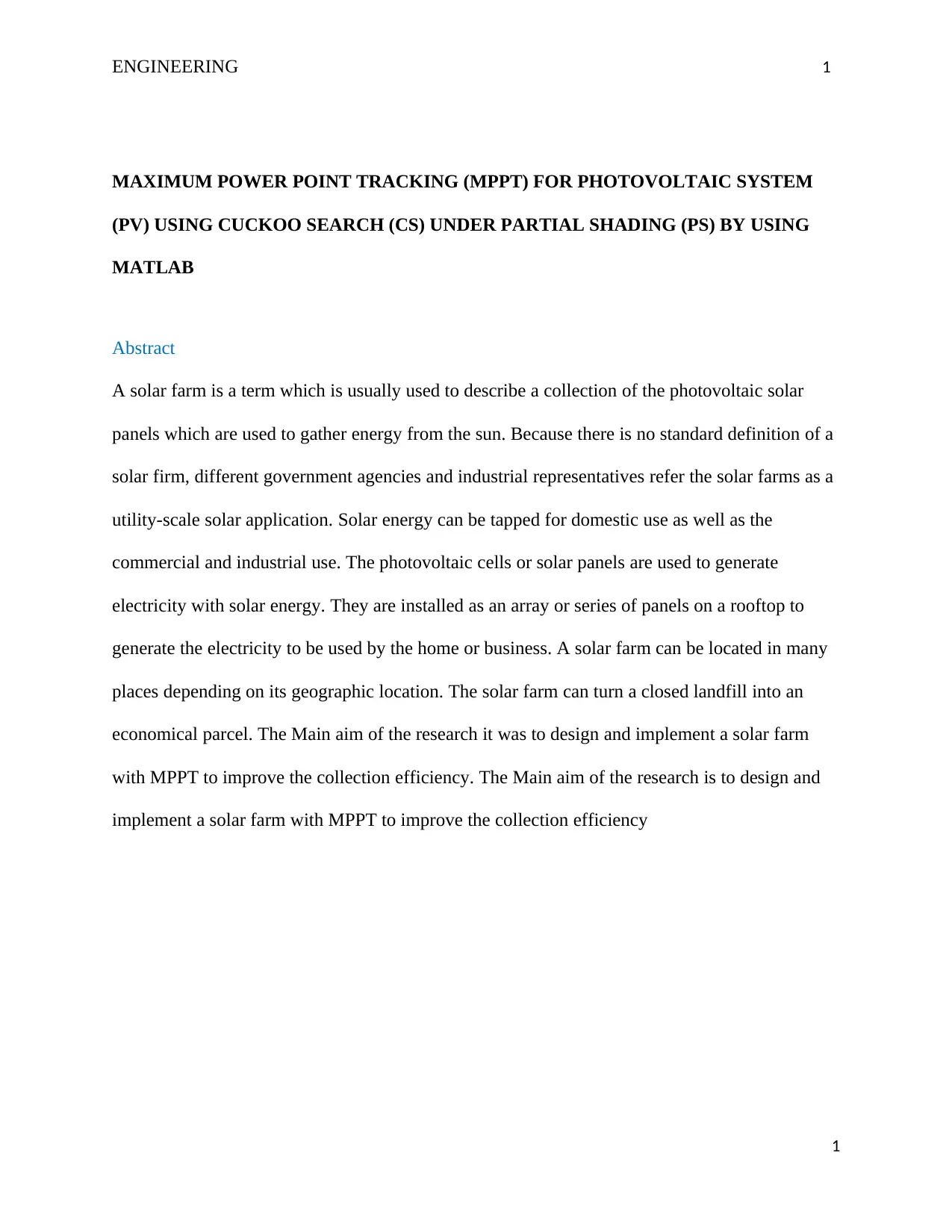
ENGINEERING 1
MAXIMUM POWER POINT TRACKING (MPPT) FOR PHOTOVOLTAIC SYSTEM
(PV) USING CUCKOO SEARCH (CS) UNDER PARTIAL SHADING (PS) BY USING
MATLAB
Abstract
A solar farm is a term which is usually used to describe a collection of the photovoltaic solar
panels which are used to gather energy from the sun. Because there is no standard definition of a
solar firm, different government agencies and industrial representatives refer the solar farms as a
utility-scale solar application. Solar energy can be tapped for domestic use as well as the
commercial and industrial use. The photovoltaic cells or solar panels are used to generate
electricity with solar energy. They are installed as an array or series of panels on a rooftop to
generate the electricity to be used by the home or business. A solar farm can be located in many
places depending on its geographic location. The solar farm can turn a closed landfill into an
economical parcel. The Main aim of the research it was to design and implement a solar farm
with MPPT to improve the collection efficiency. The Main aim of the research is to design and
implement a solar farm with MPPT to improve the collection efficiency
1
MAXIMUM POWER POINT TRACKING (MPPT) FOR PHOTOVOLTAIC SYSTEM
(PV) USING CUCKOO SEARCH (CS) UNDER PARTIAL SHADING (PS) BY USING
MATLAB
Abstract
A solar farm is a term which is usually used to describe a collection of the photovoltaic solar
panels which are used to gather energy from the sun. Because there is no standard definition of a
solar firm, different government agencies and industrial representatives refer the solar farms as a
utility-scale solar application. Solar energy can be tapped for domestic use as well as the
commercial and industrial use. The photovoltaic cells or solar panels are used to generate
electricity with solar energy. They are installed as an array or series of panels on a rooftop to
generate the electricity to be used by the home or business. A solar farm can be located in many
places depending on its geographic location. The solar farm can turn a closed landfill into an
economical parcel. The Main aim of the research it was to design and implement a solar farm
with MPPT to improve the collection efficiency. The Main aim of the research is to design and
implement a solar farm with MPPT to improve the collection efficiency
1
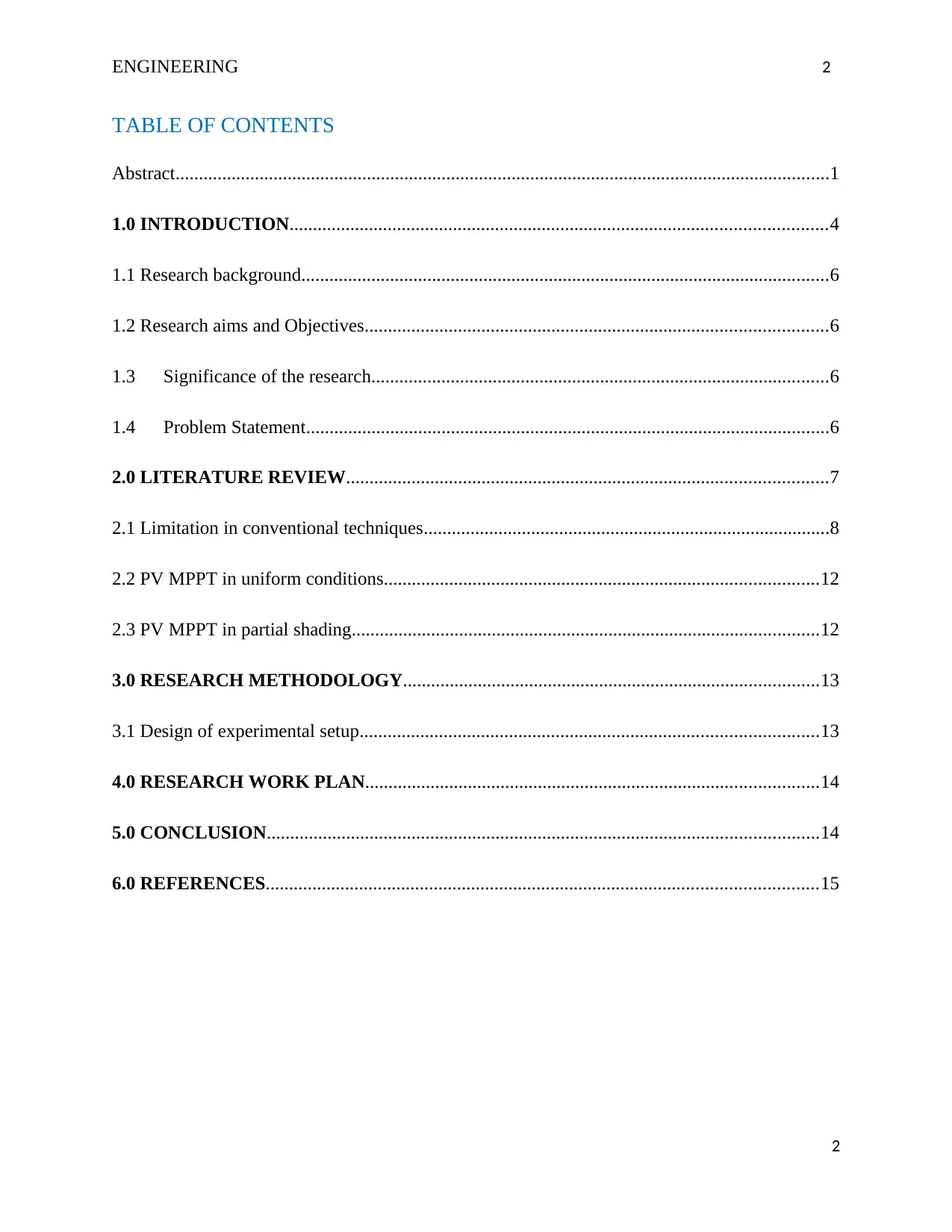
ENGINEERING 2
TABLE OF CONTENTS
Abstract............................................................................................................................................1
1.0 INTRODUCTION...................................................................................................................4
1.1 Research background.................................................................................................................6
1.2 Research aims and Objectives...................................................................................................6
1.3 Significance of the research..................................................................................................6
1.4 Problem Statement................................................................................................................6
2.0 LITERATURE REVIEW.......................................................................................................7
2.1 Limitation in conventional techniques.......................................................................................8
2.2 PV MPPT in uniform conditions.............................................................................................12
2.3 PV MPPT in partial shading....................................................................................................12
3.0 RESEARCH METHODOLOGY.........................................................................................13
3.1 Design of experimental setup..................................................................................................13
4.0 RESEARCH WORK PLAN.................................................................................................14
5.0 CONCLUSION......................................................................................................................14
6.0 REFERENCES......................................................................................................................15
2
TABLE OF CONTENTS
Abstract............................................................................................................................................1
1.0 INTRODUCTION...................................................................................................................4
1.1 Research background.................................................................................................................6
1.2 Research aims and Objectives...................................................................................................6
1.3 Significance of the research..................................................................................................6
1.4 Problem Statement................................................................................................................6
2.0 LITERATURE REVIEW.......................................................................................................7
2.1 Limitation in conventional techniques.......................................................................................8
2.2 PV MPPT in uniform conditions.............................................................................................12
2.3 PV MPPT in partial shading....................................................................................................12
3.0 RESEARCH METHODOLOGY.........................................................................................13
3.1 Design of experimental setup..................................................................................................13
4.0 RESEARCH WORK PLAN.................................................................................................14
5.0 CONCLUSION......................................................................................................................14
6.0 REFERENCES......................................................................................................................15
2
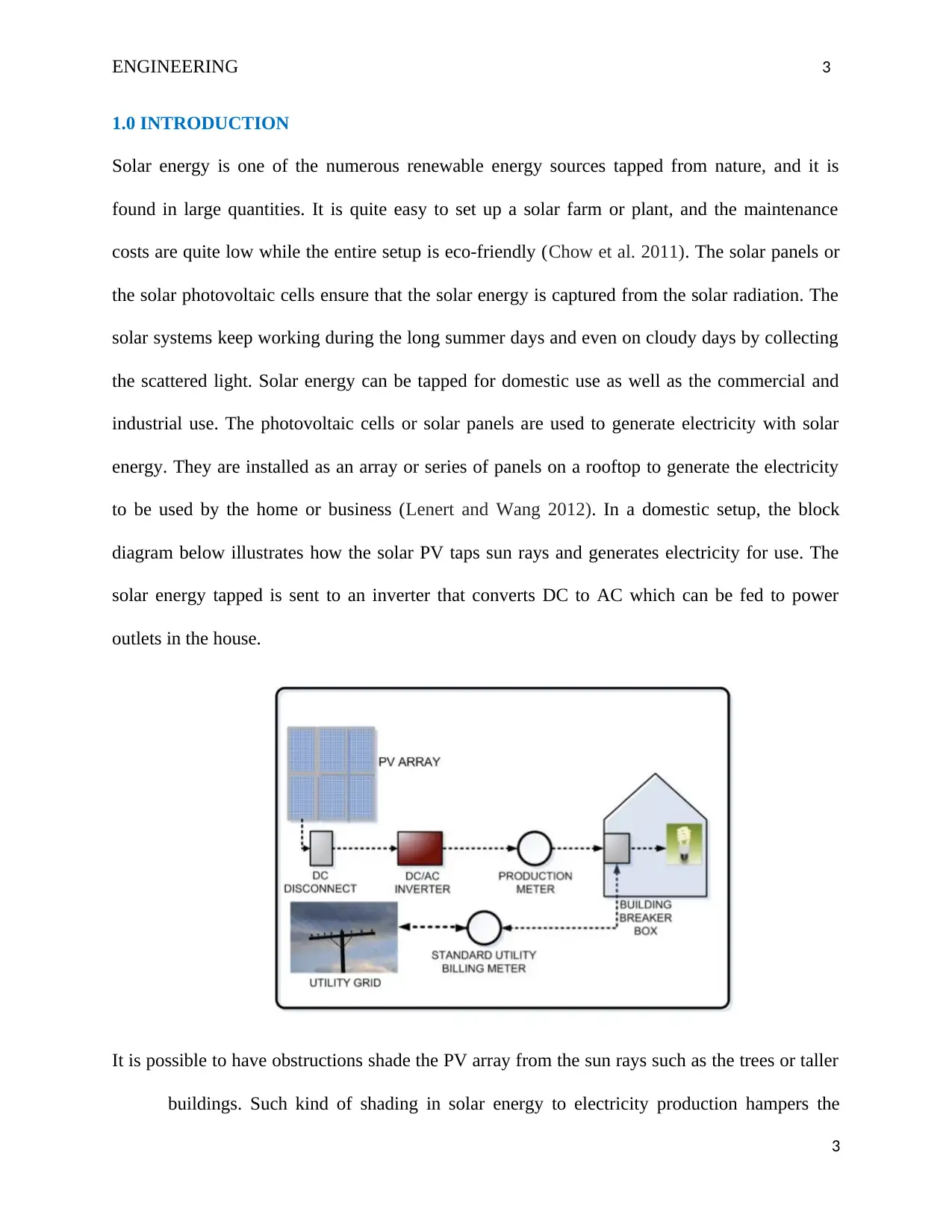
ENGINEERING 3
1.0 INTRODUCTION
Solar energy is one of the numerous renewable energy sources tapped from nature, and it is
found in large quantities. It is quite easy to set up a solar farm or plant, and the maintenance
costs are quite low while the entire setup is eco-friendly (Chow et al. 2011). The solar panels or
the solar photovoltaic cells ensure that the solar energy is captured from the solar radiation. The
solar systems keep working during the long summer days and even on cloudy days by collecting
the scattered light. Solar energy can be tapped for domestic use as well as the commercial and
industrial use. The photovoltaic cells or solar panels are used to generate electricity with solar
energy. They are installed as an array or series of panels on a rooftop to generate the electricity
to be used by the home or business (Lenert and Wang 2012). In a domestic setup, the block
diagram below illustrates how the solar PV taps sun rays and generates electricity for use. The
solar energy tapped is sent to an inverter that converts DC to AC which can be fed to power
outlets in the house.
It is possible to have obstructions shade the PV array from the sun rays such as the trees or taller
buildings. Such kind of shading in solar energy to electricity production hampers the
3
1.0 INTRODUCTION
Solar energy is one of the numerous renewable energy sources tapped from nature, and it is
found in large quantities. It is quite easy to set up a solar farm or plant, and the maintenance
costs are quite low while the entire setup is eco-friendly (Chow et al. 2011). The solar panels or
the solar photovoltaic cells ensure that the solar energy is captured from the solar radiation. The
solar systems keep working during the long summer days and even on cloudy days by collecting
the scattered light. Solar energy can be tapped for domestic use as well as the commercial and
industrial use. The photovoltaic cells or solar panels are used to generate electricity with solar
energy. They are installed as an array or series of panels on a rooftop to generate the electricity
to be used by the home or business (Lenert and Wang 2012). In a domestic setup, the block
diagram below illustrates how the solar PV taps sun rays and generates electricity for use. The
solar energy tapped is sent to an inverter that converts DC to AC which can be fed to power
outlets in the house.
It is possible to have obstructions shade the PV array from the sun rays such as the trees or taller
buildings. Such kind of shading in solar energy to electricity production hampers the
3
Secure Best Marks with AI Grader
Need help grading? Try our AI Grader for instant feedback on your assignments.
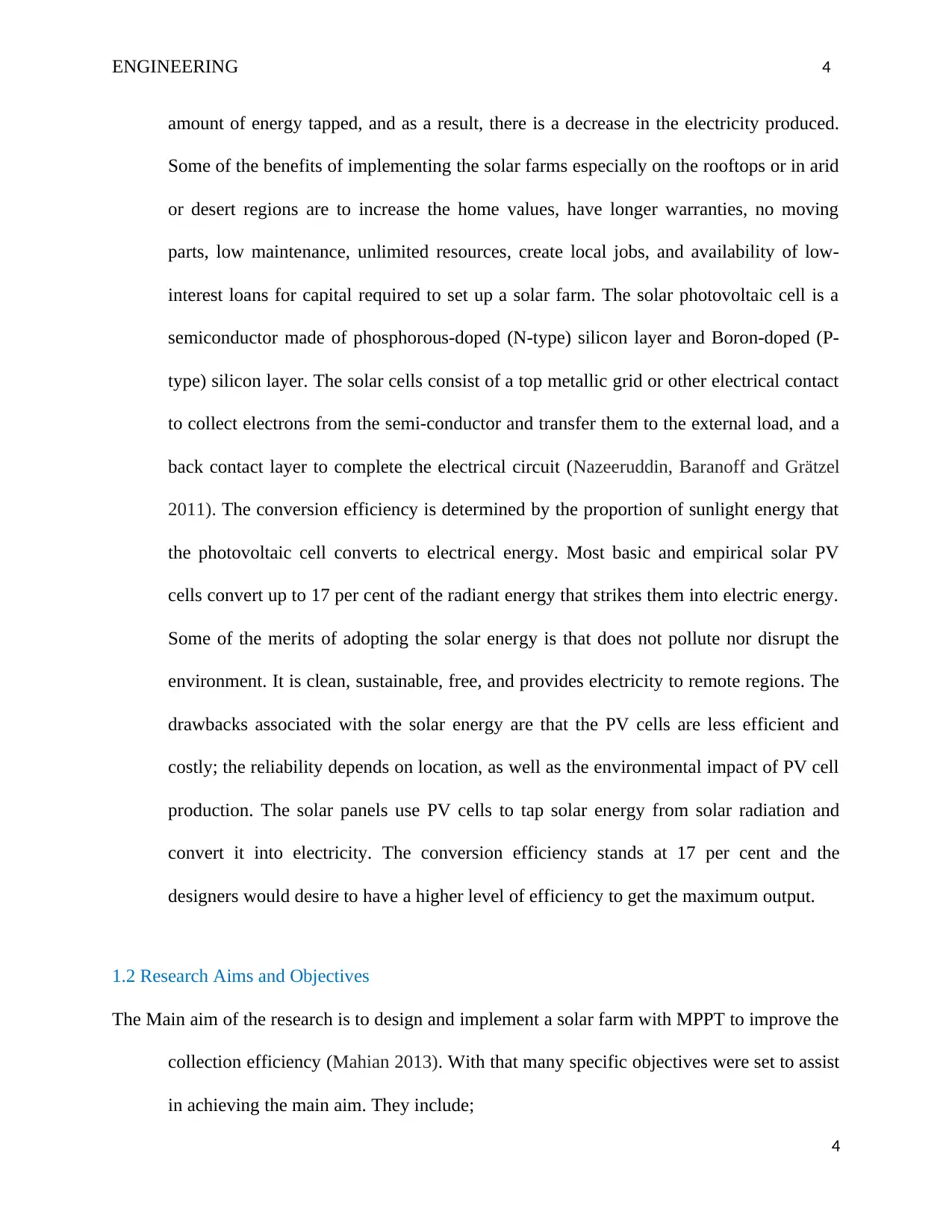
ENGINEERING 4
amount of energy tapped, and as a result, there is a decrease in the electricity produced.
Some of the benefits of implementing the solar farms especially on the rooftops or in arid
or desert regions are to increase the home values, have longer warranties, no moving
parts, low maintenance, unlimited resources, create local jobs, and availability of low-
interest loans for capital required to set up a solar farm. The solar photovoltaic cell is a
semiconductor made of phosphorous-doped (N-type) silicon layer and Boron-doped (P-
type) silicon layer. The solar cells consist of a top metallic grid or other electrical contact
to collect electrons from the semi-conductor and transfer them to the external load, and a
back contact layer to complete the electrical circuit (Nazeeruddin, Baranoff and Grätzel
2011). The conversion efficiency is determined by the proportion of sunlight energy that
the photovoltaic cell converts to electrical energy. Most basic and empirical solar PV
cells convert up to 17 per cent of the radiant energy that strikes them into electric energy.
Some of the merits of adopting the solar energy is that does not pollute nor disrupt the
environment. It is clean, sustainable, free, and provides electricity to remote regions. The
drawbacks associated with the solar energy are that the PV cells are less efficient and
costly; the reliability depends on location, as well as the environmental impact of PV cell
production. The solar panels use PV cells to tap solar energy from solar radiation and
convert it into electricity. The conversion efficiency stands at 17 per cent and the
designers would desire to have a higher level of efficiency to get the maximum output.
1.2 Research Aims and Objectives
The Main aim of the research is to design and implement a solar farm with MPPT to improve the
collection efficiency (Mahian 2013). With that many specific objectives were set to assist
in achieving the main aim. They include;
4
amount of energy tapped, and as a result, there is a decrease in the electricity produced.
Some of the benefits of implementing the solar farms especially on the rooftops or in arid
or desert regions are to increase the home values, have longer warranties, no moving
parts, low maintenance, unlimited resources, create local jobs, and availability of low-
interest loans for capital required to set up a solar farm. The solar photovoltaic cell is a
semiconductor made of phosphorous-doped (N-type) silicon layer and Boron-doped (P-
type) silicon layer. The solar cells consist of a top metallic grid or other electrical contact
to collect electrons from the semi-conductor and transfer them to the external load, and a
back contact layer to complete the electrical circuit (Nazeeruddin, Baranoff and Grätzel
2011). The conversion efficiency is determined by the proportion of sunlight energy that
the photovoltaic cell converts to electrical energy. Most basic and empirical solar PV
cells convert up to 17 per cent of the radiant energy that strikes them into electric energy.
Some of the merits of adopting the solar energy is that does not pollute nor disrupt the
environment. It is clean, sustainable, free, and provides electricity to remote regions. The
drawbacks associated with the solar energy are that the PV cells are less efficient and
costly; the reliability depends on location, as well as the environmental impact of PV cell
production. The solar panels use PV cells to tap solar energy from solar radiation and
convert it into electricity. The conversion efficiency stands at 17 per cent and the
designers would desire to have a higher level of efficiency to get the maximum output.
1.2 Research Aims and Objectives
The Main aim of the research is to design and implement a solar farm with MPPT to improve the
collection efficiency (Mahian 2013). With that many specific objectives were set to assist
in achieving the main aim. They include;
4
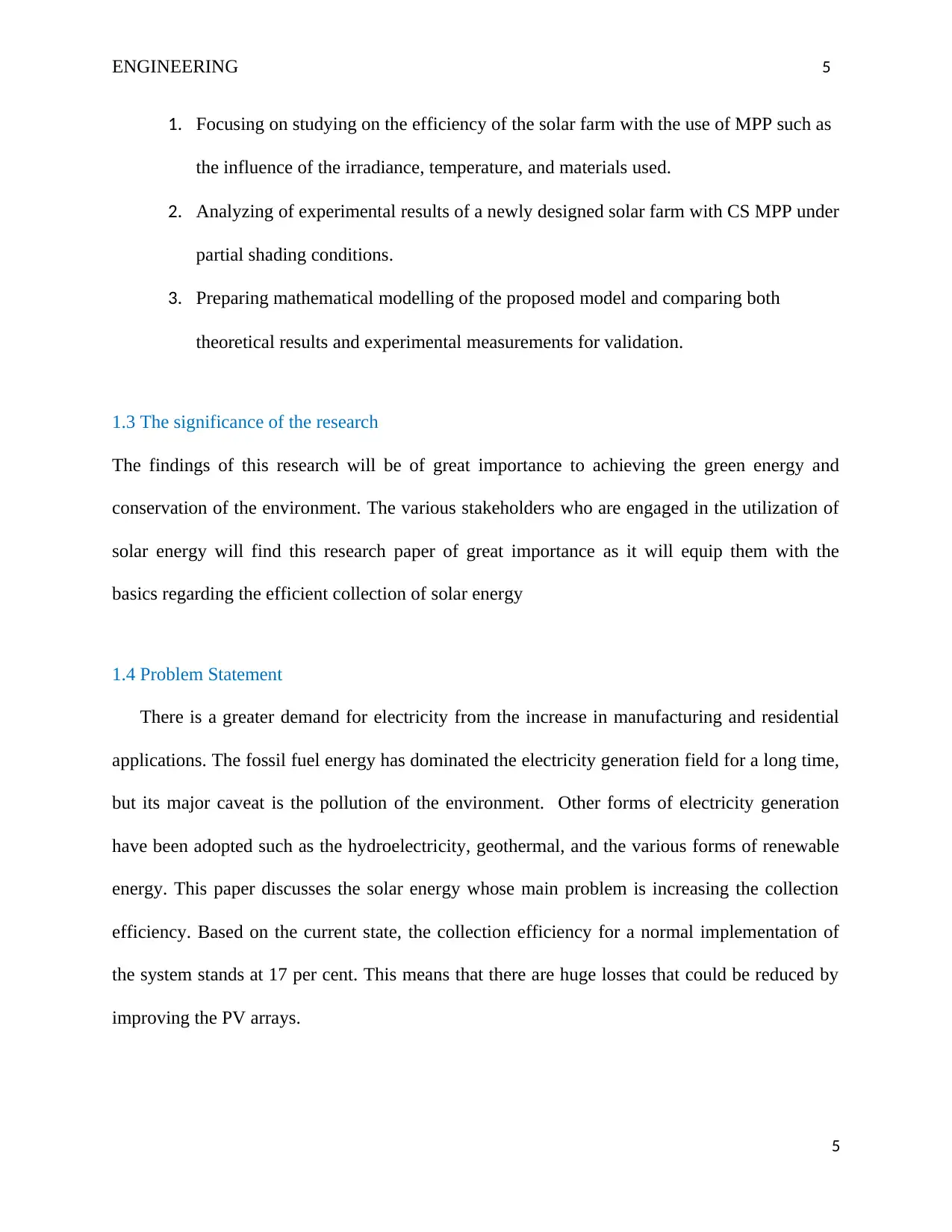
ENGINEERING 5
1. Focusing on studying on the efficiency of the solar farm with the use of MPP such as
the influence of the irradiance, temperature, and materials used.
2. Analyzing of experimental results of a newly designed solar farm with CS MPP under
partial shading conditions.
3. Preparing mathematical modelling of the proposed model and comparing both
theoretical results and experimental measurements for validation.
1.3 The significance of the research
The findings of this research will be of great importance to achieving the green energy and
conservation of the environment. The various stakeholders who are engaged in the utilization of
solar energy will find this research paper of great importance as it will equip them with the
basics regarding the efficient collection of solar energy
1.4 Problem Statement
There is a greater demand for electricity from the increase in manufacturing and residential
applications. The fossil fuel energy has dominated the electricity generation field for a long time,
but its major caveat is the pollution of the environment. Other forms of electricity generation
have been adopted such as the hydroelectricity, geothermal, and the various forms of renewable
energy. This paper discusses the solar energy whose main problem is increasing the collection
efficiency. Based on the current state, the collection efficiency for a normal implementation of
the system stands at 17 per cent. This means that there are huge losses that could be reduced by
improving the PV arrays.
5
1. Focusing on studying on the efficiency of the solar farm with the use of MPP such as
the influence of the irradiance, temperature, and materials used.
2. Analyzing of experimental results of a newly designed solar farm with CS MPP under
partial shading conditions.
3. Preparing mathematical modelling of the proposed model and comparing both
theoretical results and experimental measurements for validation.
1.3 The significance of the research
The findings of this research will be of great importance to achieving the green energy and
conservation of the environment. The various stakeholders who are engaged in the utilization of
solar energy will find this research paper of great importance as it will equip them with the
basics regarding the efficient collection of solar energy
1.4 Problem Statement
There is a greater demand for electricity from the increase in manufacturing and residential
applications. The fossil fuel energy has dominated the electricity generation field for a long time,
but its major caveat is the pollution of the environment. Other forms of electricity generation
have been adopted such as the hydroelectricity, geothermal, and the various forms of renewable
energy. This paper discusses the solar energy whose main problem is increasing the collection
efficiency. Based on the current state, the collection efficiency for a normal implementation of
the system stands at 17 per cent. This means that there are huge losses that could be reduced by
improving the PV arrays.
5

ENGINEERING 6
2.0 LITERATURE REVIEW
For an industrial implementation of the PV array, the solar panel is installed alongside the dc
load as shown before,
The mathematical model is utilized in developing the PV array on simulation software. An
equivalent PV array is implemented as shown below,
For a PV panel, the following equation is used,
I pv =np I ph−n p Irs [e
q
kTA
V pv
ns
−1 ]
The equation is used to determine the maximum power, voltage and current at the short circuit
and open circuit, the temperature, the short circuit current coefficient and the open circuit
voltage coefficient (Pospischil, Furchi and Mueller 2014). The solar irradiation and
temperature affect the output power characteristics of the PV system as a function of
irradiance and temperature curves that are non-linear. The operating point of the
6
2.0 LITERATURE REVIEW
For an industrial implementation of the PV array, the solar panel is installed alongside the dc
load as shown before,
The mathematical model is utilized in developing the PV array on simulation software. An
equivalent PV array is implemented as shown below,
For a PV panel, the following equation is used,
I pv =np I ph−n p Irs [e
q
kTA
V pv
ns
−1 ]
The equation is used to determine the maximum power, voltage and current at the short circuit
and open circuit, the temperature, the short circuit current coefficient and the open circuit
voltage coefficient (Pospischil, Furchi and Mueller 2014). The solar irradiation and
temperature affect the output power characteristics of the PV system as a function of
irradiance and temperature curves that are non-linear. The operating point of the
6
Paraphrase This Document
Need a fresh take? Get an instant paraphrase of this document with our AI Paraphraser
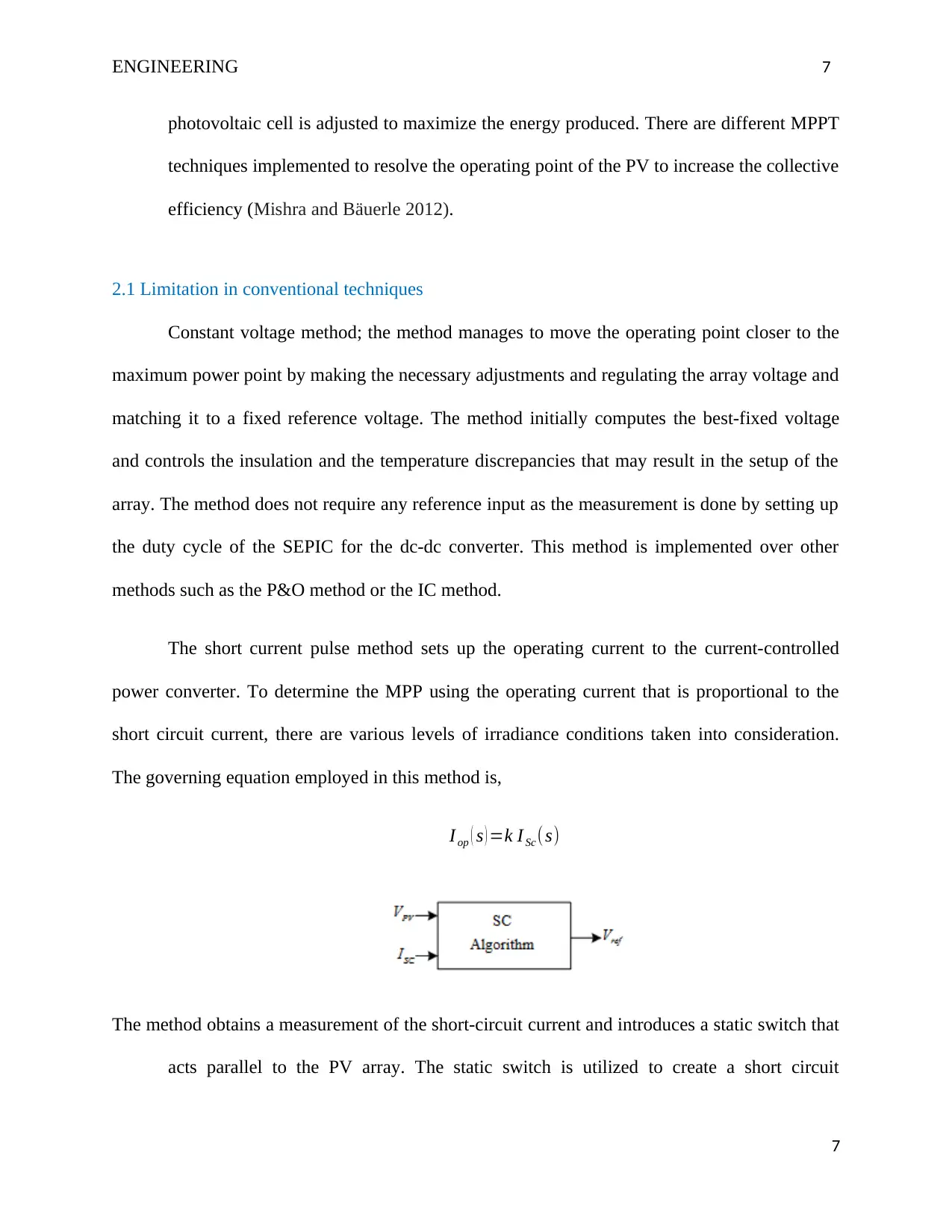
ENGINEERING 7
photovoltaic cell is adjusted to maximize the energy produced. There are different MPPT
techniques implemented to resolve the operating point of the PV to increase the collective
efficiency (Mishra and Bäuerle 2012).
2.1 Limitation in conventional techniques
Constant voltage method; the method manages to move the operating point closer to the
maximum power point by making the necessary adjustments and regulating the array voltage and
matching it to a fixed reference voltage. The method initially computes the best-fixed voltage
and controls the insulation and the temperature discrepancies that may result in the setup of the
array. The method does not require any reference input as the measurement is done by setting up
the duty cycle of the SEPIC for the dc-dc converter. This method is implemented over other
methods such as the P&O method or the IC method.
The short current pulse method sets up the operating current to the current-controlled
power converter. To determine the MPP using the operating current that is proportional to the
short circuit current, there are various levels of irradiance conditions taken into consideration.
The governing equation employed in this method is,
I op ( s ) =k I Sc(s)
The method obtains a measurement of the short-circuit current and introduces a static switch that
acts parallel to the PV array. The static switch is utilized to create a short circuit
7
photovoltaic cell is adjusted to maximize the energy produced. There are different MPPT
techniques implemented to resolve the operating point of the PV to increase the collective
efficiency (Mishra and Bäuerle 2012).
2.1 Limitation in conventional techniques
Constant voltage method; the method manages to move the operating point closer to the
maximum power point by making the necessary adjustments and regulating the array voltage and
matching it to a fixed reference voltage. The method initially computes the best-fixed voltage
and controls the insulation and the temperature discrepancies that may result in the setup of the
array. The method does not require any reference input as the measurement is done by setting up
the duty cycle of the SEPIC for the dc-dc converter. This method is implemented over other
methods such as the P&O method or the IC method.
The short current pulse method sets up the operating current to the current-controlled
power converter. To determine the MPP using the operating current that is proportional to the
short circuit current, there are various levels of irradiance conditions taken into consideration.
The governing equation employed in this method is,
I op ( s ) =k I Sc(s)
The method obtains a measurement of the short-circuit current and introduces a static switch that
acts parallel to the PV array. The static switch is utilized to create a short circuit
7
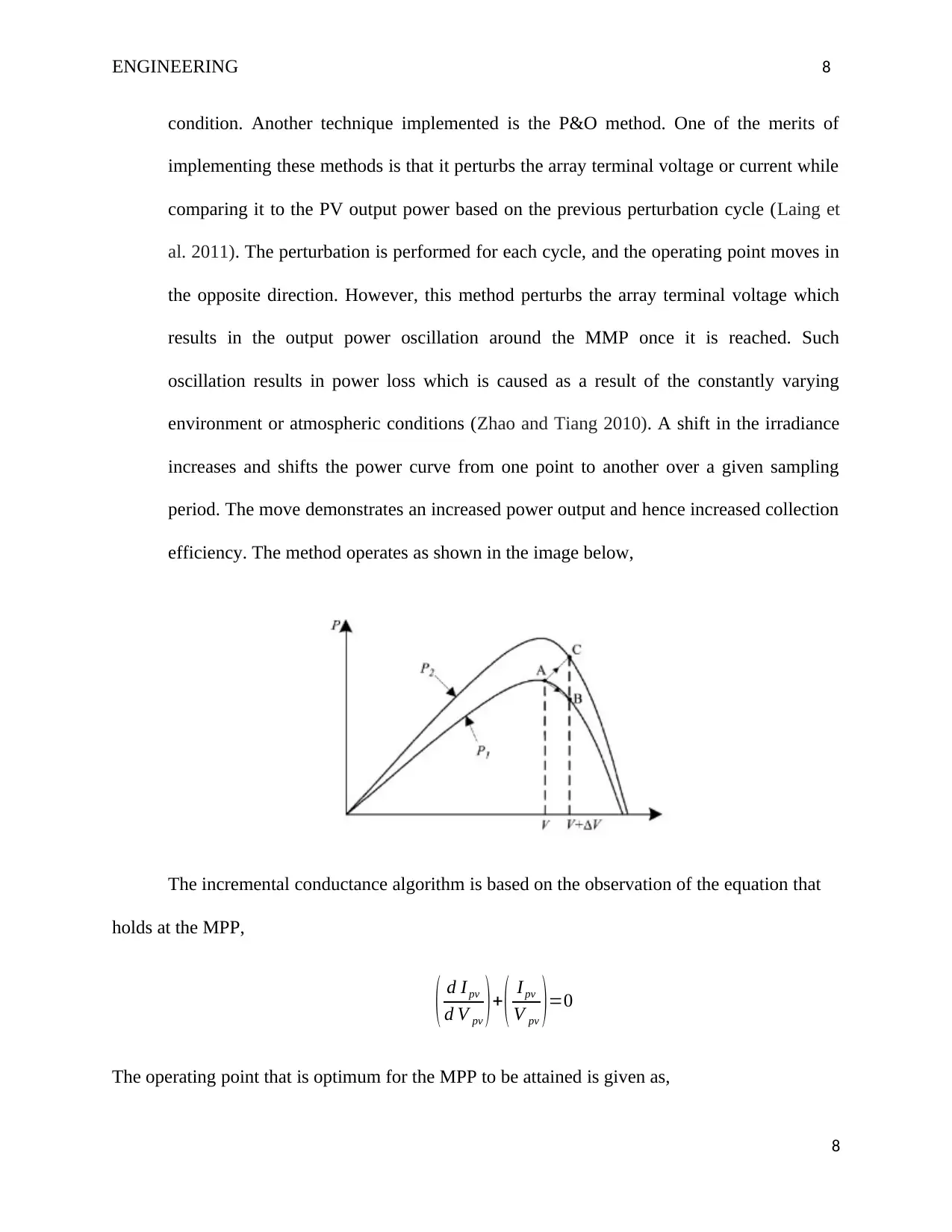
ENGINEERING 8
condition. Another technique implemented is the P&O method. One of the merits of
implementing these methods is that it perturbs the array terminal voltage or current while
comparing it to the PV output power based on the previous perturbation cycle (Laing et
al. 2011). The perturbation is performed for each cycle, and the operating point moves in
the opposite direction. However, this method perturbs the array terminal voltage which
results in the output power oscillation around the MMP once it is reached. Such
oscillation results in power loss which is caused as a result of the constantly varying
environment or atmospheric conditions (Zhao and Tiang 2010). A shift in the irradiance
increases and shifts the power curve from one point to another over a given sampling
period. The move demonstrates an increased power output and hence increased collection
efficiency. The method operates as shown in the image below,
The incremental conductance algorithm is based on the observation of the equation that
holds at the MPP,
( d I pv
d V pv ) + ( Ipv
V pv ) =0
The operating point that is optimum for the MPP to be attained is given as,
8
condition. Another technique implemented is the P&O method. One of the merits of
implementing these methods is that it perturbs the array terminal voltage or current while
comparing it to the PV output power based on the previous perturbation cycle (Laing et
al. 2011). The perturbation is performed for each cycle, and the operating point moves in
the opposite direction. However, this method perturbs the array terminal voltage which
results in the output power oscillation around the MMP once it is reached. Such
oscillation results in power loss which is caused as a result of the constantly varying
environment or atmospheric conditions (Zhao and Tiang 2010). A shift in the irradiance
increases and shifts the power curve from one point to another over a given sampling
period. The move demonstrates an increased power output and hence increased collection
efficiency. The method operates as shown in the image below,
The incremental conductance algorithm is based on the observation of the equation that
holds at the MPP,
( d I pv
d V pv ) + ( Ipv
V pv ) =0
The operating point that is optimum for the MPP to be attained is given as,
8
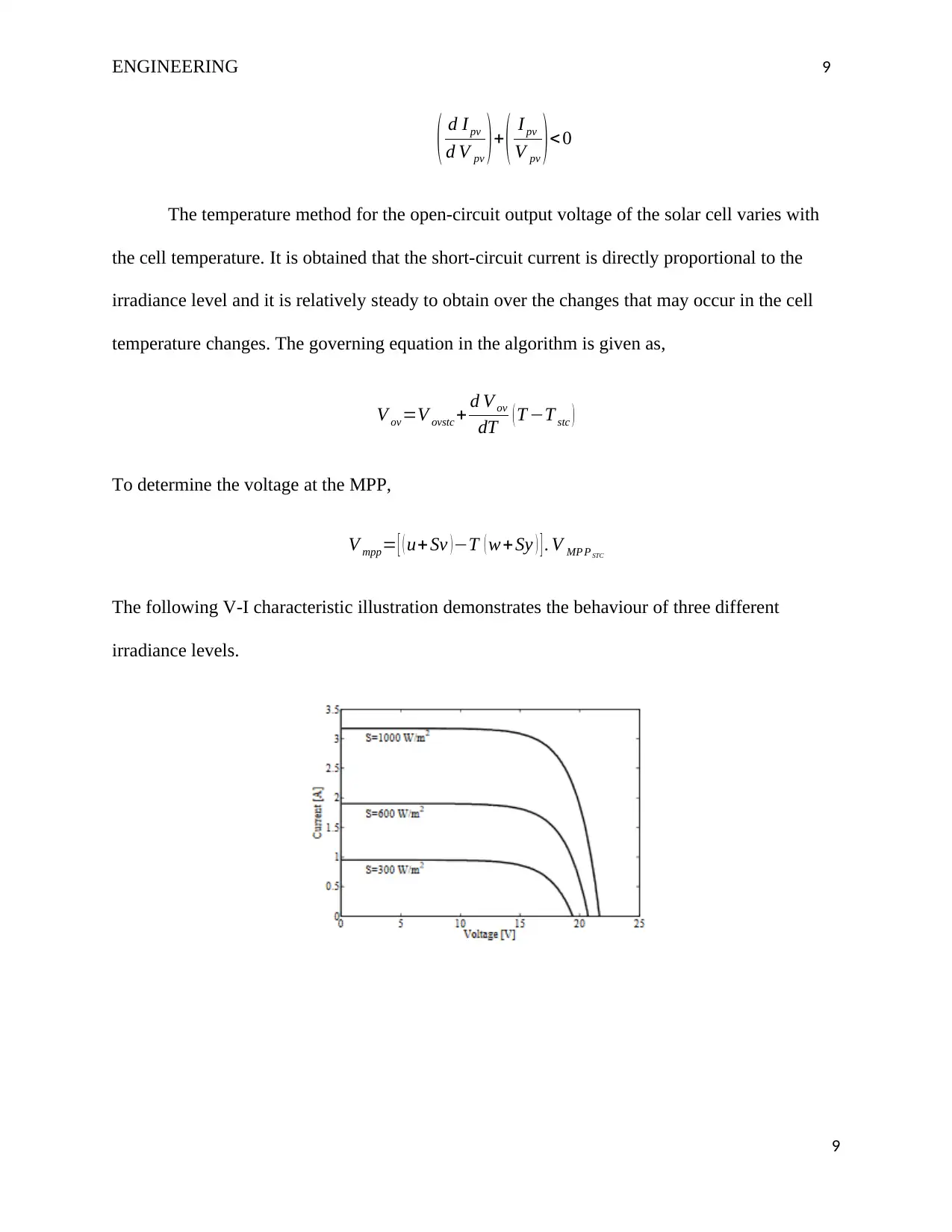
ENGINEERING 9
( d Ipv
d V pv )+ ( Ipv
V pv )< 0
The temperature method for the open-circuit output voltage of the solar cell varies with
the cell temperature. It is obtained that the short-circuit current is directly proportional to the
irradiance level and it is relatively steady to obtain over the changes that may occur in the cell
temperature changes. The governing equation in the algorithm is given as,
V ov=V ovstc + d V ov
dT ( T −T stc )
To determine the voltage at the MPP,
V mpp= [ ( u+ Sv ) −T ( w+ Sy ) ] . V MP P STC
The following V-I characteristic illustration demonstrates the behaviour of three different
irradiance levels.
9
( d Ipv
d V pv )+ ( Ipv
V pv )< 0
The temperature method for the open-circuit output voltage of the solar cell varies with
the cell temperature. It is obtained that the short-circuit current is directly proportional to the
irradiance level and it is relatively steady to obtain over the changes that may occur in the cell
temperature changes. The governing equation in the algorithm is given as,
V ov=V ovstc + d V ov
dT ( T −T stc )
To determine the voltage at the MPP,
V mpp= [ ( u+ Sv ) −T ( w+ Sy ) ] . V MP P STC
The following V-I characteristic illustration demonstrates the behaviour of three different
irradiance levels.
9
Secure Best Marks with AI Grader
Need help grading? Try our AI Grader for instant feedback on your assignments.

ENGINEERING 10
The temperature model is discussed when the temperature is uniformly distributed such that,
S= T
R +C dT
dt
The thermal system equivalent circuit is given as,
Regarding cost evaluation, the algorithms implemented rate as follows,
10
The temperature model is discussed when the temperature is uniformly distributed such that,
S= T
R +C dT
dt
The thermal system equivalent circuit is given as,
Regarding cost evaluation, the algorithms implemented rate as follows,
10
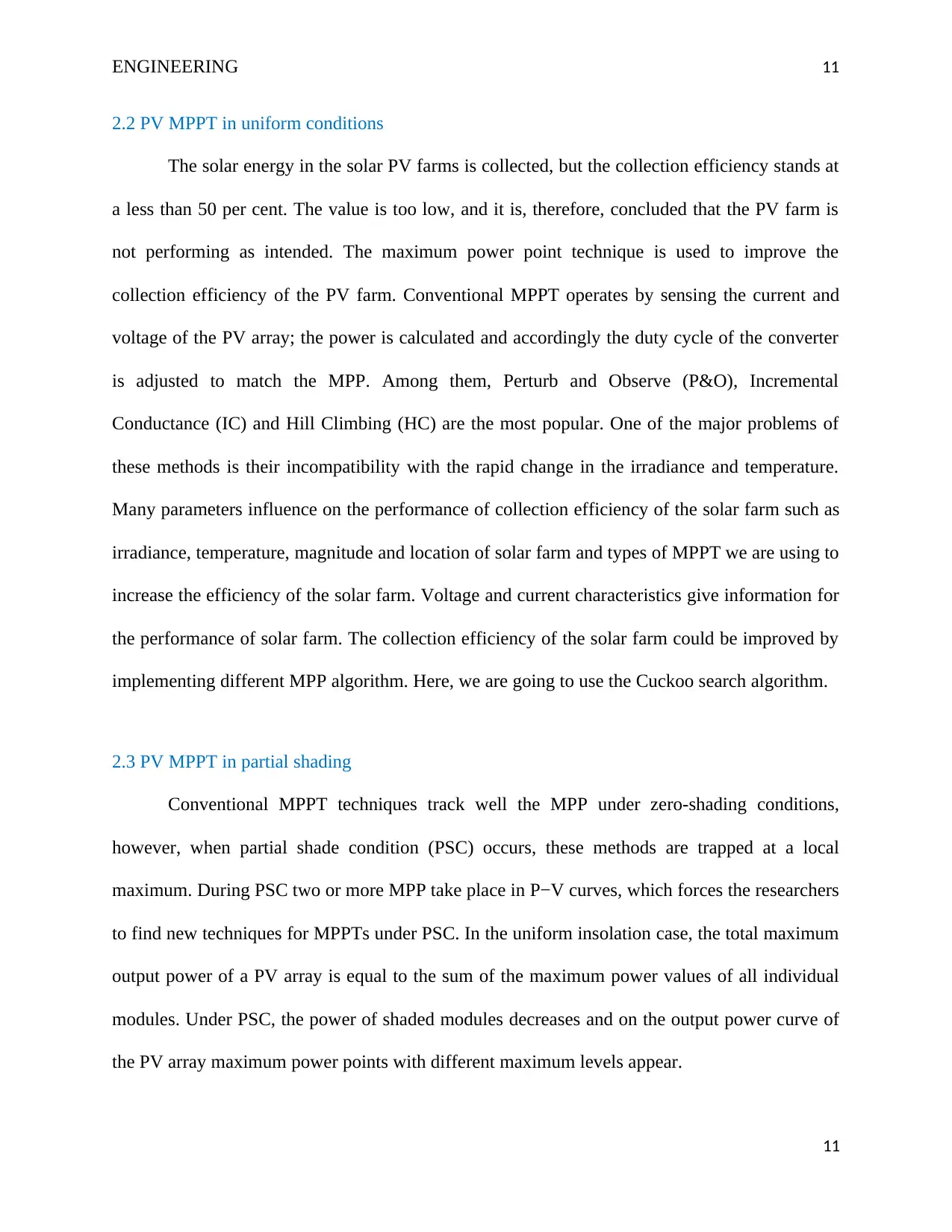
ENGINEERING 11
2.2 PV MPPT in uniform conditions
The solar energy in the solar PV farms is collected, but the collection efficiency stands at
a less than 50 per cent. The value is too low, and it is, therefore, concluded that the PV farm is
not performing as intended. The maximum power point technique is used to improve the
collection efficiency of the PV farm. Conventional MPPT operates by sensing the current and
voltage of the PV array; the power is calculated and accordingly the duty cycle of the converter
is adjusted to match the MPP. Among them, Perturb and Observe (P&O), Incremental
Conductance (IC) and Hill Climbing (HC) are the most popular. One of the major problems of
these methods is their incompatibility with the rapid change in the irradiance and temperature.
Many parameters influence on the performance of collection efficiency of the solar farm such as
irradiance, temperature, magnitude and location of solar farm and types of MPPT we are using to
increase the efficiency of the solar farm. Voltage and current characteristics give information for
the performance of solar farm. The collection efficiency of the solar farm could be improved by
implementing different MPP algorithm. Here, we are going to use the Cuckoo search algorithm.
2.3 PV MPPT in partial shading
Conventional MPPT techniques track well the MPP under zero-shading conditions,
however, when partial shade condition (PSC) occurs, these methods are trapped at a local
maximum. During PSC two or more MPP take place in P−V curves, which forces the researchers
to find new techniques for MPPTs under PSC. In the uniform insolation case, the total maximum
output power of a PV array is equal to the sum of the maximum power values of all individual
modules. Under PSC, the power of shaded modules decreases and on the output power curve of
the PV array maximum power points with different maximum levels appear.
11
2.2 PV MPPT in uniform conditions
The solar energy in the solar PV farms is collected, but the collection efficiency stands at
a less than 50 per cent. The value is too low, and it is, therefore, concluded that the PV farm is
not performing as intended. The maximum power point technique is used to improve the
collection efficiency of the PV farm. Conventional MPPT operates by sensing the current and
voltage of the PV array; the power is calculated and accordingly the duty cycle of the converter
is adjusted to match the MPP. Among them, Perturb and Observe (P&O), Incremental
Conductance (IC) and Hill Climbing (HC) are the most popular. One of the major problems of
these methods is their incompatibility with the rapid change in the irradiance and temperature.
Many parameters influence on the performance of collection efficiency of the solar farm such as
irradiance, temperature, magnitude and location of solar farm and types of MPPT we are using to
increase the efficiency of the solar farm. Voltage and current characteristics give information for
the performance of solar farm. The collection efficiency of the solar farm could be improved by
implementing different MPP algorithm. Here, we are going to use the Cuckoo search algorithm.
2.3 PV MPPT in partial shading
Conventional MPPT techniques track well the MPP under zero-shading conditions,
however, when partial shade condition (PSC) occurs, these methods are trapped at a local
maximum. During PSC two or more MPP take place in P−V curves, which forces the researchers
to find new techniques for MPPTs under PSC. In the uniform insolation case, the total maximum
output power of a PV array is equal to the sum of the maximum power values of all individual
modules. Under PSC, the power of shaded modules decreases and on the output power curve of
the PV array maximum power points with different maximum levels appear.
11
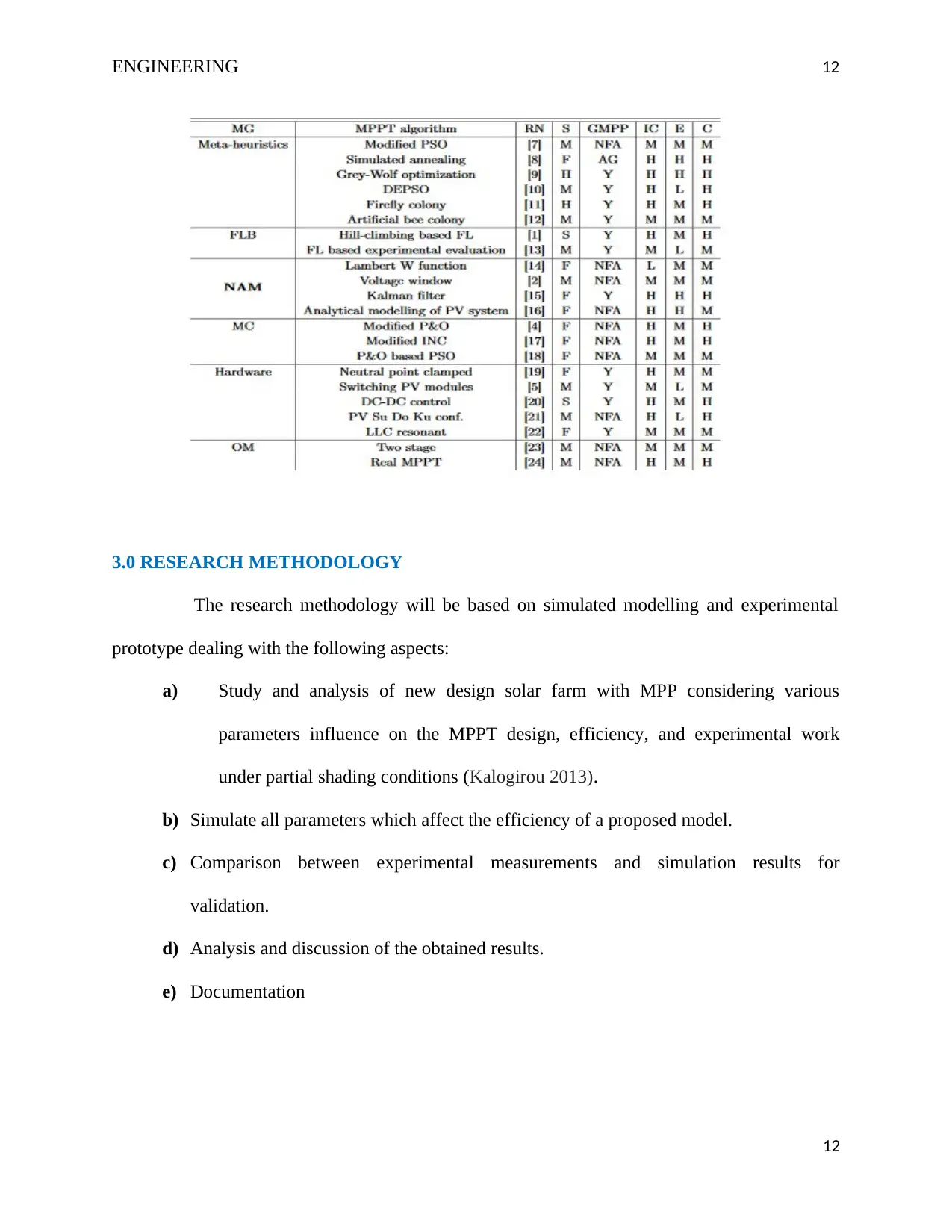
ENGINEERING 12
3.0 RESEARCH METHODOLOGY
The research methodology will be based on simulated modelling and experimental
prototype dealing with the following aspects:
a) Study and analysis of new design solar farm with MPP considering various
parameters influence on the MPPT design, efficiency, and experimental work
under partial shading conditions (Kalogirou 2013).
b) Simulate all parameters which affect the efficiency of a proposed model.
c) Comparison between experimental measurements and simulation results for
validation.
d) Analysis and discussion of the obtained results.
e) Documentation
12
3.0 RESEARCH METHODOLOGY
The research methodology will be based on simulated modelling and experimental
prototype dealing with the following aspects:
a) Study and analysis of new design solar farm with MPP considering various
parameters influence on the MPPT design, efficiency, and experimental work
under partial shading conditions (Kalogirou 2013).
b) Simulate all parameters which affect the efficiency of a proposed model.
c) Comparison between experimental measurements and simulation results for
validation.
d) Analysis and discussion of the obtained results.
e) Documentation
12
Paraphrase This Document
Need a fresh take? Get an instant paraphrase of this document with our AI Paraphraser
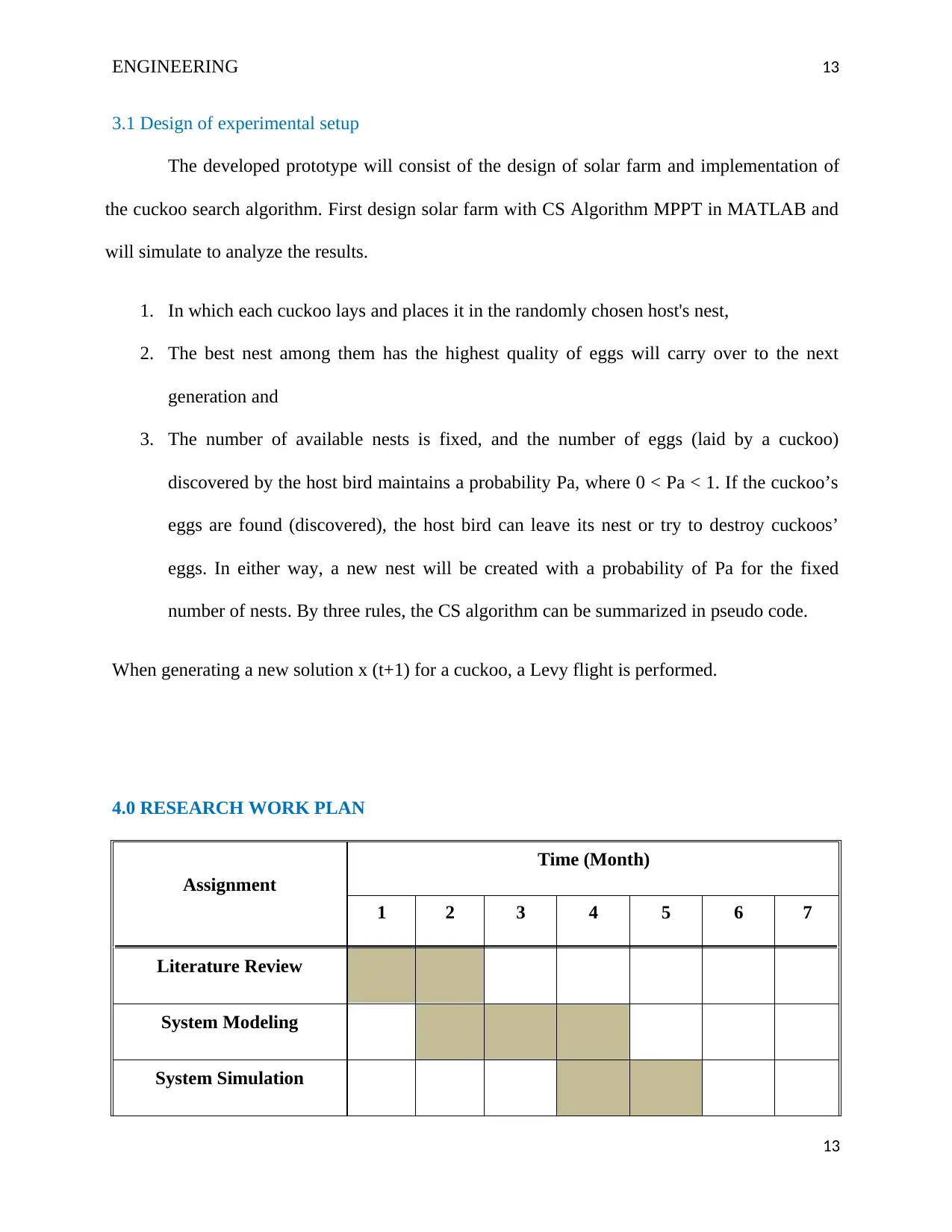
ENGINEERING 13
3.1 Design of experimental setup
The developed prototype will consist of the design of solar farm and implementation of
the cuckoo search algorithm. First design solar farm with CS Algorithm MPPT in MATLAB and
will simulate to analyze the results.
1. In which each cuckoo lays and places it in the randomly chosen host's nest,
2. The best nest among them has the highest quality of eggs will carry over to the next
generation and
3. The number of available nests is fixed, and the number of eggs (laid by a cuckoo)
discovered by the host bird maintains a probability Pa, where 0 < Pa < 1. If the cuckoo’s
eggs are found (discovered), the host bird can leave its nest or try to destroy cuckoos’
eggs. In either way, a new nest will be created with a probability of Pa for the fixed
number of nests. By three rules, the CS algorithm can be summarized in pseudo code.
When generating a new solution x (t+1) for a cuckoo, a Levy flight is performed.
4.0 RESEARCH WORK PLAN
Assignment
Time (Month)
1 2 3 4 5 6 7
Literature Review
System Modeling
System Simulation
13
3.1 Design of experimental setup
The developed prototype will consist of the design of solar farm and implementation of
the cuckoo search algorithm. First design solar farm with CS Algorithm MPPT in MATLAB and
will simulate to analyze the results.
1. In which each cuckoo lays and places it in the randomly chosen host's nest,
2. The best nest among them has the highest quality of eggs will carry over to the next
generation and
3. The number of available nests is fixed, and the number of eggs (laid by a cuckoo)
discovered by the host bird maintains a probability Pa, where 0 < Pa < 1. If the cuckoo’s
eggs are found (discovered), the host bird can leave its nest or try to destroy cuckoos’
eggs. In either way, a new nest will be created with a probability of Pa for the fixed
number of nests. By three rules, the CS algorithm can be summarized in pseudo code.
When generating a new solution x (t+1) for a cuckoo, a Levy flight is performed.
4.0 RESEARCH WORK PLAN
Assignment
Time (Month)
1 2 3 4 5 6 7
Literature Review
System Modeling
System Simulation
13
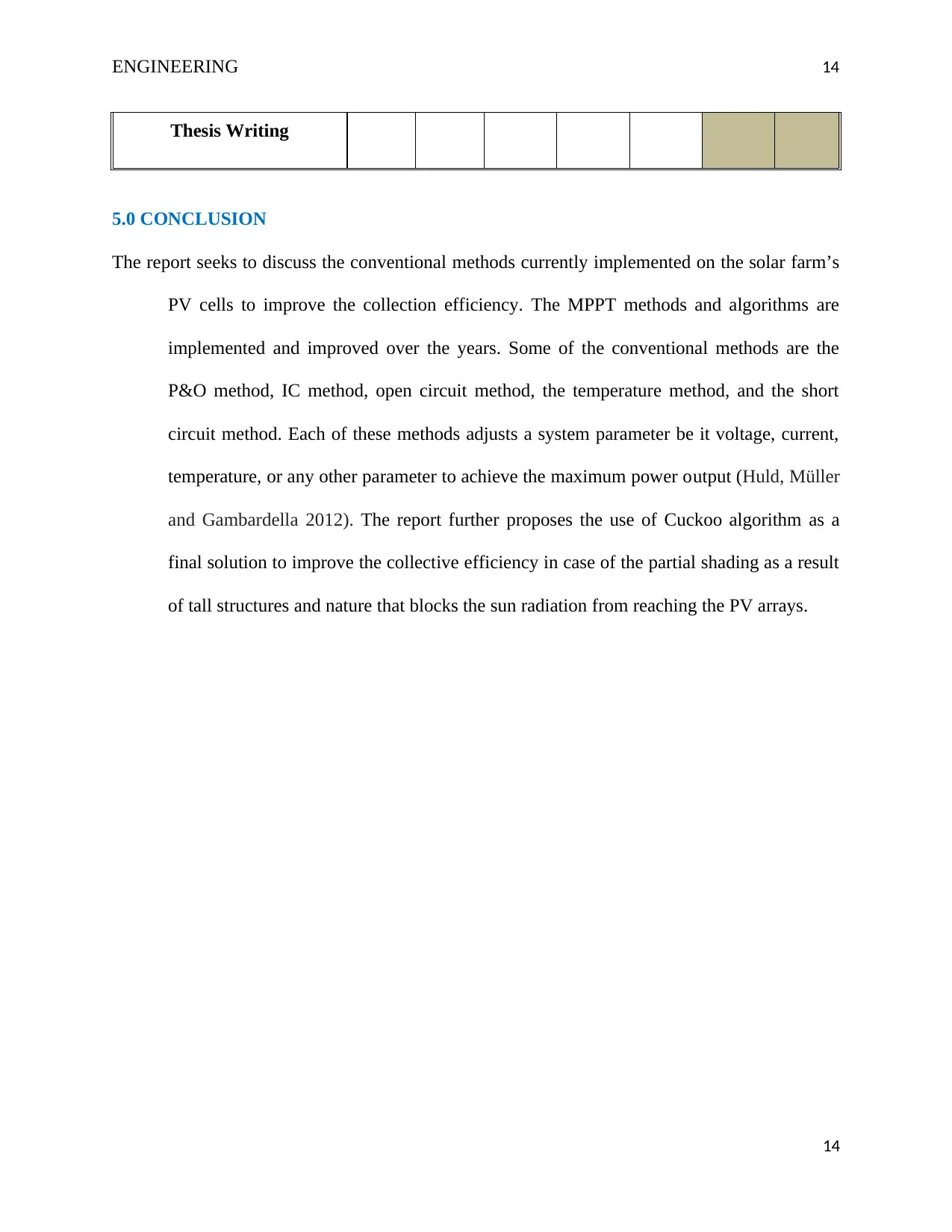
ENGINEERING 14
Thesis Writing
5.0 CONCLUSION
The report seeks to discuss the conventional methods currently implemented on the solar farm’s
PV cells to improve the collection efficiency. The MPPT methods and algorithms are
implemented and improved over the years. Some of the conventional methods are the
P&O method, IC method, open circuit method, the temperature method, and the short
circuit method. Each of these methods adjusts a system parameter be it voltage, current,
temperature, or any other parameter to achieve the maximum power output (Huld, Müller
and Gambardella 2012). The report further proposes the use of Cuckoo algorithm as a
final solution to improve the collective efficiency in case of the partial shading as a result
of tall structures and nature that blocks the sun radiation from reaching the PV arrays.
14
Thesis Writing
5.0 CONCLUSION
The report seeks to discuss the conventional methods currently implemented on the solar farm’s
PV cells to improve the collection efficiency. The MPPT methods and algorithms are
implemented and improved over the years. Some of the conventional methods are the
P&O method, IC method, open circuit method, the temperature method, and the short
circuit method. Each of these methods adjusts a system parameter be it voltage, current,
temperature, or any other parameter to achieve the maximum power output (Huld, Müller
and Gambardella 2012). The report further proposes the use of Cuckoo algorithm as a
final solution to improve the collective efficiency in case of the partial shading as a result
of tall structures and nature that blocks the sun radiation from reaching the PV arrays.
14

ENGINEERING 15
6.0 REFERENCES
Chow, C. W., Urquhart, B., Lave, M., Dominguez, A., Kleissl, J., Shields, J., & Washom, B.
(2011). Intra-hour forecasting with a total sky imager at the UC San Diego solar energy
testbed. Solar Energy, 85(11), 2881-2893.
Huld, T., Müller, R., & Gambardella, A. (2012). A new solar radiation database for estimating
PV performance in Europe and Africa. Solar Energy, 86(6), 1803-1815.
Kalogirou, S. A. (2013). Solar energy engineering: processes and systems. Academic Press.
Laing, D., Bahl, C., Bauer, T., Lehmann, D., & Steinmann, W. D. (2011). Thermal energy
storage for direct steam generation. Solar Energy, 85(4), 627-633.
Lenert, A., & Wang, E. N. (2012). Optimization of nanofluid volumetric receivers for solar
thermal energy conversion. Solar Energy, 86(1), 253-265.
Mahian, O., Kianifar, A., Kalogirou, S. A., Pop, I., & Wongwises, S. (2013). A review of the
applications of nanofluids in solar energy. International Journal of Heat and Mass
Transfer, 57(2), 582-594.
Mishra, A., & Bäuerle, P. (2012). Small molecule organic semiconductors on the move:
promises for future solar energy technology. Angewandte Chemie International Edition, 51(9),
2020-2067.
Nazeeruddin, M. K., Baranoff, E., & Grätzel, M. (2011). Dye-sensitized solar cells: a brief
overview. Solar energy, 85(6), 1172-1178.
Pospischil, A., Furchi, M. M., & Mueller, T. (2014). Solar-energy conversion and light emission
in an atomic monolayer pn diode. Nature nanotechnology, 9(4), 257-261.
15
6.0 REFERENCES
Chow, C. W., Urquhart, B., Lave, M., Dominguez, A., Kleissl, J., Shields, J., & Washom, B.
(2011). Intra-hour forecasting with a total sky imager at the UC San Diego solar energy
testbed. Solar Energy, 85(11), 2881-2893.
Huld, T., Müller, R., & Gambardella, A. (2012). A new solar radiation database for estimating
PV performance in Europe and Africa. Solar Energy, 86(6), 1803-1815.
Kalogirou, S. A. (2013). Solar energy engineering: processes and systems. Academic Press.
Laing, D., Bahl, C., Bauer, T., Lehmann, D., & Steinmann, W. D. (2011). Thermal energy
storage for direct steam generation. Solar Energy, 85(4), 627-633.
Lenert, A., & Wang, E. N. (2012). Optimization of nanofluid volumetric receivers for solar
thermal energy conversion. Solar Energy, 86(1), 253-265.
Mahian, O., Kianifar, A., Kalogirou, S. A., Pop, I., & Wongwises, S. (2013). A review of the
applications of nanofluids in solar energy. International Journal of Heat and Mass
Transfer, 57(2), 582-594.
Mishra, A., & Bäuerle, P. (2012). Small molecule organic semiconductors on the move:
promises for future solar energy technology. Angewandte Chemie International Edition, 51(9),
2020-2067.
Nazeeruddin, M. K., Baranoff, E., & Grätzel, M. (2011). Dye-sensitized solar cells: a brief
overview. Solar energy, 85(6), 1172-1178.
Pospischil, A., Furchi, M. M., & Mueller, T. (2014). Solar-energy conversion and light emission
in an atomic monolayer pn diode. Nature nanotechnology, 9(4), 257-261.
15
Secure Best Marks with AI Grader
Need help grading? Try our AI Grader for instant feedback on your assignments.
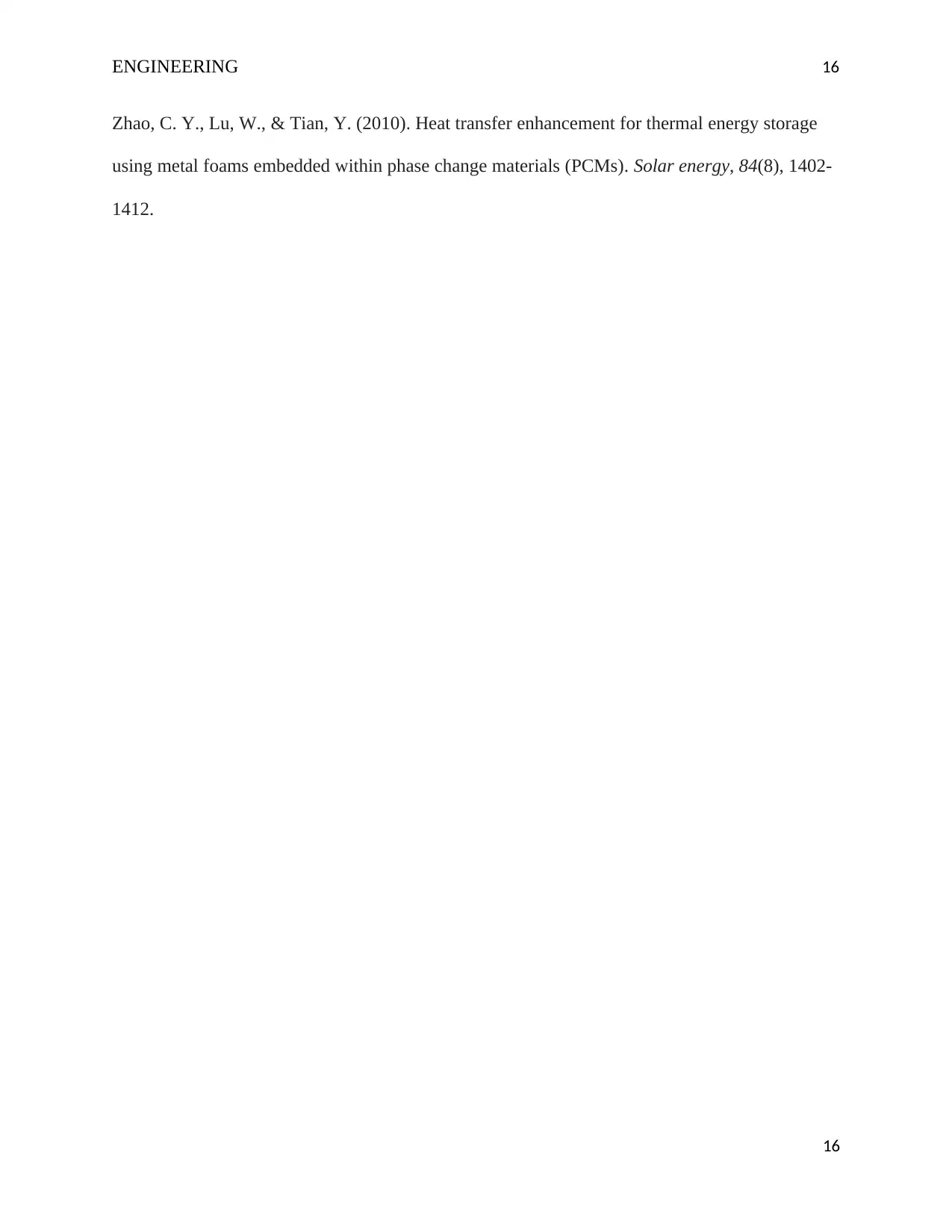
ENGINEERING 16
Zhao, C. Y., Lu, W., & Tian, Y. (2010). Heat transfer enhancement for thermal energy storage
using metal foams embedded within phase change materials (PCMs). Solar energy, 84(8), 1402-
1412.
16
Zhao, C. Y., Lu, W., & Tian, Y. (2010). Heat transfer enhancement for thermal energy storage
using metal foams embedded within phase change materials (PCMs). Solar energy, 84(8), 1402-
1412.
16
1 out of 17
Related Documents
Your All-in-One AI-Powered Toolkit for Academic Success.
+13062052269
info@desklib.com
Available 24*7 on WhatsApp / Email
![[object Object]](/_next/static/media/star-bottom.7253800d.svg)
Unlock your academic potential
© 2024 | Zucol Services PVT LTD | All rights reserved.





